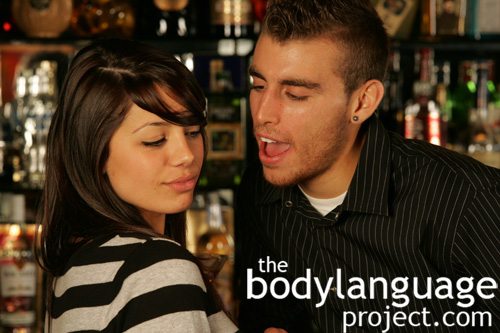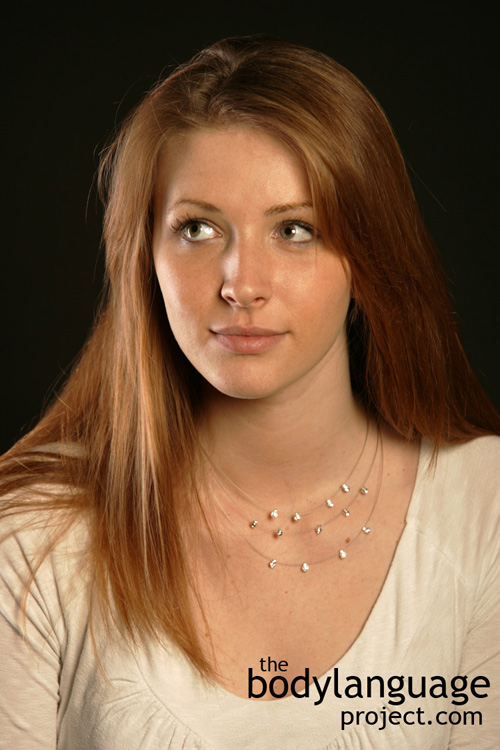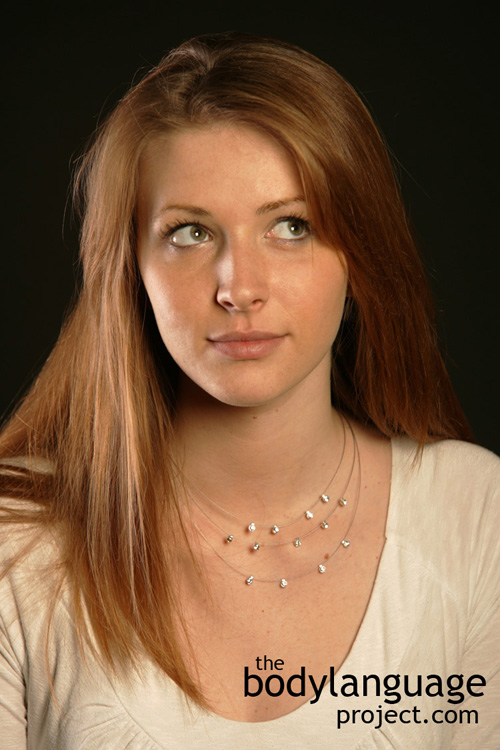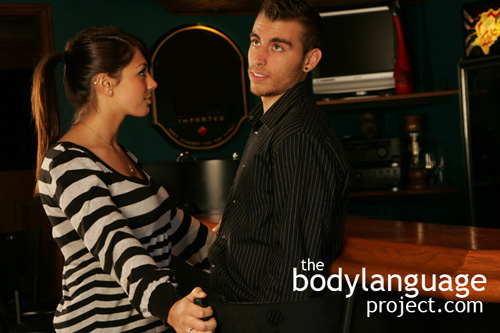Body Language of Micronodding
Synonym(s): N/A
Description: A barely perceptible dip of the head usually at the end of a sentence or statement with a return to the upright position.
In One Sentence: Micronodding tells others that concealed agreement is present.
How To Use it: Use the micronod to encourage others to speak without signaling a desire to cut them off. A micronod is a way to tell others that you agree with them without being overt. It’s also useful when you don’t want to be called upon to add anything new to a conversation – a silent agreement.
When you boss is speaking, a micronod can signal that you and he are on the same page. The same works between spouses and friends. A micronod can also substitute for actual listening. A few nods here and there will show that you are “listening.” Most will read this as “I understand.”
The micronod can also punctuate sentences, especially when they are provocative. In other words, a micronod is a way to throw down a challenge. This will help assert your points and show others that you are confident in what you are saying.
Context: General.
Verbal Translation: a) “I’m fully committed to my statement and nod slightly to show that I’m willing to stand behind it. I issue my confidence in my idea as a challenge.” b) “I agree with what you are saying, but don’t want to be known for it so I’m doing my best to stifle it.”
Variant: See Head Nod.
Cue In Action: George Bush habitually micronodded his head while uttering the words “make no mistake.”
Meaning and/or Motivation: A micronod is usually aimed at the listener as a slight attack and commitment to what is being said.
Other times, a micronod signals covert or reserved agreement which is stifled, but still manages to leak from the body. In this form, it signals that a person does not wish to be known for agreement. Take for example a micronod while agreeing that the team of which you form a part, isn’t as superior to the other team. While you might consciously or even subconsciously agree with the statement, you wouldn’t want to overtly endorse it to betray your teammates or admit weakness.
Cue Cluster: N/A
Body Language Category: Leaked or involuntary body language, Microgestures, Micromessaging.
Resources:
Austin, Keith ; Theakston, Anna ; Lieven, Elena ; Tomasello, Michael Eccles, Jacquelynne S. (editor). Young Children’s Understanding of Denial. Developmental Psychology. 2014. 50(8): 2061-2070.
Akiyama, M. M. (1985). Denials in young children from a cross-linguistic perspective. Child Development, 56, 95–102. doi:10.2307/1130177
Cassell, J., & Thórisson, K. R. (1999). The power of a nod and a glance: Envelope vs.
emotional feedback in animated conversational agents. Applied Artificial Intelligence, 13, 519–538.
Cameron-Faulkner, T., Lieven, E., & Theakston, A. (2007). What part of no do children not understand? A usage-based account of multiword negation. Journal of Child Language, 34, 251–282. doi:10.1016/j.cognition.2010.08.017
Ekman, P., & Friesen, W. V. The Repertoire of Nonverbal Behavior: Categories, Origins, Usage, and Coding. Semiotica. 1969. 1: 49–98.
http://bodylanguageproject.com/articles/relationship-verbal-nonverbal-communication/
Fusaro, M., & Harris, P. L. (2013). Dax gets the nod: Toddlers detect and use social cues to evaluate testimony. Developmental Psychology, 49, 514–522. doi:10.1037/a0030580
Fusaro, M., Harris, P. L., & Pan, B. A. (2012). Head nodding and head shaking gestures in children’s early communication. First Language, 32, 439–458. doi:10.1177/0142723711419326
Gräfenhain, M., Behne, T., Carpenter, M., & Tomasello, M. (2009). One-year-olds’ understanding of nonverbal gestures directed to a third person. Cognitive Development, 24, 23–33. doi:10.1016/j.cogdev.2008.10.001
Guidetti, M. (2005). Yes or no? How do young children combine gestures and words to agree and refuse. Journal of Child Language, 32, 911–924. doi:10.1017/S0305000905007038
Gregersen, Tammy S. Nonverbal Cues: Clues to the Detection of Foreign Language Anxiety. Foreign Language Annals. 2005. 38(3): 388-400
http://bodylanguageproject.com/articles/what-anxious-learners-can-tell-us-about-anxious-body-language-how-to-read-nonverbal-behavior/
Hurley, Carolyn. Do you see what I see? Learning to detect micro expressions of emotion. Motivation and Emotion. 2012. 36(3): 371-381.
Hall, Jeffrey A. and Chong Xing. The Verbal and Nonverbal Correlates of the Five Flirting Styles. Journal of Nonverbal Behavior. 2015. 39:41–68. DOI 10.1007/s10919-014-0199-8
http://bodylanguageproject.com/articles/first-12-minutes-flirting-using-nonverbal-communication-study-reveals-26-body-language-cues-attraction/
Hummer, P., Wimmer, H., & Antes, G. (1993). On the origins of denial negation. Journal of Child Language, 20, 607– 618. doi:10.1017/S0305000900008503
Hurley, Carolyn. Do you see what I see? Learning to detect micro expressions of emotion. Motivation and Emotion. 2012. 36(3): 371-381.
Kim, K. J. (1985). Development of the concept of truth-functional negation. Developmental Psychology, 21, 462–472. doi:10.1037/0012-1649.21.3.462
Liu, C., Ishi, C. T., Ishiguro, H., & Hagita, N. (2012). Generation of nodding, head tilting and eye gazing for human–robot dialogue interaction. In Human–Robot interaction (HRI), 2012 7th ACM/IEEE international conference on (pp. 285–292). IEEE Press.
Murphy, Nora A.; Judith A. Hall; Marianne Schmid Mast; Mollie A. Ruben; Denise Frauendorfer; Danielle Blanch-Hartigan; Debra L. Roter and Laurent Nguyen. Reliability and Validity of Nonverbal Thin Slices in Social Interactions. Personality and Social Psychology Bulletin. 2015 41(2): 199-213.
http://bodylanguageproject.com/articles/thin-slices-nonverbal-behaviour-enough/
Matsumoto, David ; Hwang, Hyi. Evidence for training the ability to read microexpressions of emotion. Motivation and Emotion. 2011. 35(2): 181-191.
Porter, Stephen ; Ten Brinke, Leanne. Reading between the lies: identifying concealed and falsified emotions in universal facial expressions. Psychological science. 2008. 19(5): 508-14.
Shen, Xun-bing ; Wu, Qi ; Fu, Xiao-lan. Effects of the duration of expressions on the recognition of microexpressions. Journal of Zhejiang University. 2012. 13(3): 221-230.
Sun Jung, Hyo Sun and Hye Hyun Yoon. The Effects of Nonverbal Communication of Employees in the Family Restaurant Upon Customers’ Emotional Responses and Customer Satisfaction. International Journal of Hospitality Management. 2011. 30: 542-550.
http://bodylanguageproject.com/articles/effect-body-languagel-cues-family-restaurant/
Teixeira Fiquer, Juliana; Paulo Sérgio Boggio and Clarice Gorenstein. Talking Bodies: Nonverbal Behavior in the Assessment of Depression Severity. Journal of Affective Disorders. 2013. 150: 1114-1119.
http://bodylanguageproject.com/articles/using-nonverbal-behaviour-to-assess-depression-severity/
Teixeira Fiquer, Juliana; Paulo Sérgio Boggio and Clarice Gorenstein. Talking Bodies: Nonverbal Behavior in the Assessment of Depression Severity. Journal of Affective Disorders. 2013. 150: 1114-1119.
http://bodylanguageproject.com/articles/using-nonverbal-behaviour-to-assess-depression-severity/
Tam, C. W., & Stokes, S. F. (2001). Form and function of negation in early developmental Cantonese. Journal of Child Language, 28, 373–391. doi:10.1017/S0305000901004688
Vaidyanathan, R. (1991). Development of forms and functions of negation in the early. tages of language acquisition: A study in Tamil. Journal of Child Language, 18, 51–66. doi:10.1017/S0305000900013295
Ventreli, Mario R. ; Simon, Neal. How I learned to stop worrying about liars and love microexpressions. American Journal of Family Law. 2012. 25(4): 143(5).
Wode, H. (1977). Four early stages in the development of L1 negation. Journal of Child Language, 4, 87–102. doi:10.1017/S0305000900000490
Wells, Gary, L. and Richard E. Petty. The Effects of Overt Head Movements on Persuasion: Compatibility and Incompatibility of Responses. Basic and Applied Social Psychology. 1980. 1(3): 219-230.
http://bodylanguageproject.com/articles/how-learning-primes-body-language-on-head-nodding-nonverbals/
Young, Stephen. Micro messaging : why great leadership is beyond words. New York. McGraw-Hill. 2007.
Yan, Wen-Jing ; Wu, Qi ; Liang, Jing ; Chen, Yu-Hsin ; Fu, Xiaolan. How Fast are the Leaked Facial Expressions: The Duration of Micro-Expressions. Journal of Nonverbal Behavior. 2013. 37(4): 217-230.






